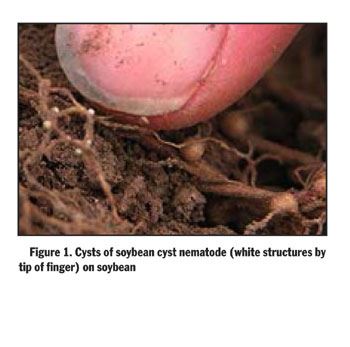Sampling For Soybean Cyst Nematode
PRINCETON, KY.
Soybean cyst nematode (SCN; Fig 1) continues to be the most serious disease pest of soybean in Kentucky and the US. This pest is controlled by rotating fields to non-host crops, such as corn, and by planting soybean cultivars that resist SCN. The problem is that in order for these tactics to be used properly, their effectiveness must be monitored over time. For example, some SCN-resistant cultivars do not resist SCN as well as other cultivars. In addition, how SCN populations respond to a year in corn can be highly variable, depending on the field and the year. The bottom line is that you cannot just implement SCN control measure and then expect them to work with little to no oversight.

One of the best ways to “keep tabs” on how different management practices are impacting SCN is to periodically monitor SCN populations. This will allow you to identify fields where adjustments need to be made, such as planting a different SCN-resistant cultivar. However, because SCN rarely causes symptoms to develop in fields–even when substantial yield losses are occurring–it is very easy to pass over SCN as a reason why fields may not be yielding as well as they should. Unfortunately, few soybean producers in KY sample their fields for SCN, even though the cost of analysis ($10/sample) is paid for by the Kentucky Soybean Promotion Board and has been for many years.
There is no time like the present to begin sampling fields for SCN analysis. Fall, in fact, is the ideal time to sample fields for SCN. Generally, fields targeted for SCN sampling will be planted to soybean the following year. Thus, most sampling in KY should take place following corn harvest. SCN and soil fertility samples can usually be based on the same sample, with the sample being split. For more information on how to collect and submit SCN soil samples, please look on-line at the below link, or stop by your local county Extension office for more information.
http://www.ca.uky.edu/agcollege/plantpathology/ext_files/PPFShtml/PPFS-AG-S-9.pdf Δ
DR. DON HERSHMAN: Extension Plant Pathologist, University of Kentucky